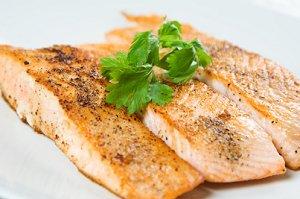
Many people know that the Vitamin D is produced through exposure to the sun, but there are other sources of Vitamin D that can be vital to an individual's nutritional needs and an overall healthy diet.
About Vitamin D
Vitamin D is primarily responsible for controlling the body's absorption of calcium and is essential for maintaining strong bones and teeth. The nutrient also helps regulate blood pressure, prevents chronic joint and muscle pain, and lowers fatigue and depression, among other health benefits.
It is recommended that both adults and children take in at least five micrograms (200 IU) of Vitamin D each day. After age 50, the dosage should increase to 10 micrograms (400 IU) per day to help compensate for greater bone calcium loss. After age 70, the recommended dosage increases again, to 15 micrograms per day (600 IU). Several studies have indicated that young children may need greater amounts of Vitamin D as well, since their bodies and bones are undergoing rapid growth that requires larger amounts of calcium.
Deficiency
An individual who exhibits Vitamin D deficiency symptoms may develop deformed bones, easy fractures, high blood pressure, chronic pain or fatigue, periodontal disease, and other health problems. While sources of Vitamin D are relatively plentiful, individuals with liver and kidney disorders may have difficulty metabolizing the nutrient into usable forms, and darker skin can make it difficult to get enough sun exposure for adequate Vitamin D levels.
Overdose
At the same time, a Vitamin D overdose can result in nausea, vomiting, constipation, loss of appetite, heart rhythm abnormalities, and an increased risk of kidney stones. While the Vitamin D that the body manufactures from exposure to ultraviolet radiation in sunlight is also broken down by sunlight making an overdose unlikely, too much Vitamin D ingested from dietary sources or supplements can have these and other detrimental effects.
Vitamin D From the Sun
Vitamin D is known as the "sunshine" vitamin for good reason: it is the only nutrient that the human body can readily manufacture for itself with proper sun exposure. The body can use UVB radiation in sunlight to create Vitamin D, and depending on a person's skin tone, as little as 10 minutes of daily sun exposure can create a full day's recommended supply of the nutrient.
While longer sun exposure is not detrimental with regards to Vitamin D production - the sunlight also helps break down excessive amounts of the nutrient - individuals should be aware of the health risks associated with too much sun exposure, including the increased risk of skin cancer.
Alternative Sources of Vitamin D
If an individual is unable to manufacture sufficient amounts of Vitamin D naturally, they can turn to a diet high in the nutrient to meet their nutritional needs. Unfortunately, very few foods contain Vitamin D, but suitable quantities can be found in:
- Salmon
- Tuna
- Mackerel
- Cod liver oil
- Beef liver

- Swiss cheese
- Egg yolks
- Sardines
- Oysters
- Shrimp
Fortified Foods
If an individual is allergic to seafood or does not regularly eat the few food sources of Vitamin D, there are other options for obtaining this nutrient. In the 1930s, to combat rickets in children, the United States began a milk fortification program that added Vitamin D to processed milk and virtually eliminated the disease. Along with milk, other foods such as cereals, orange juice, and yogurt are fortified with Vitamin D, making it easier to get enough of the nutrient in any diet.While Vitamin D is added to milk, it is important to note that many foods made with milk, including processed cheese, chocolate, and ice cream, are not similarly fortified. Individuals looking for Vitamin D in processed foods should carefully read nutritional labels to ensure that essential nutrients are present.
Vitamin D supplements are also available from pharmacies and health food stores in varying quantities. Vitamin D is present in many multivitamins, or it may be purchased as an independent supplement.
Adding More Vitamin D to Your Diet
The easiest way to enjoy a diet rich in Vitamin D is to add more fortified milk to daily menus. A breakfast of fortified cereal topped with fortified milk can provide one-quarter or more of a day's supply, and adding healthy fish to other meals can ensure adequate Vitamin D intake. There are many delicious options for adding fish to a diet, including grilling, baking, broiling, or even rolling sushi.
Recipes that are made with fortified milk, such as instant pudding, baking, or sauces, can also help increase Vitamin D intake. When adding fortified milk as an ingredient, however, cooks should note that other ingredients such as butter and sugar can make those treats less healthy and they should be enjoyed only in moderation, not justified as sources of Vitamin D.
Cooking With Vitamin D
Many nutrients can be harmed or destroyed by long storage or improper cooking, but this is not true with Vitamin D. The nutrient is extremely stable and can be effectively stored in foods for long periods of time, and different cooking methods do not break down the nutrient. This gives cooks greater flexibility with the few foods that do contain Vitamin D, and many delicious dishes are possible that can help create a healthy diet.
By understanding the different sunlight and food sources of Vitamin D, it is possible to create a healthy diet and lifestyle rich in this essential nutrient that will lead to strong bones, healthy teeth, and a D-lightful nutritional balance in life.







